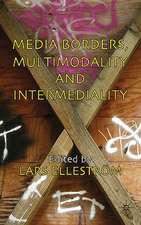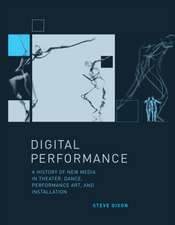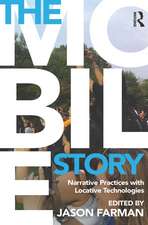A History of Video Art
Autor Prof. Chris Meigh-Andrewsen Limba Engleză Paperback – 6 noi 2013
Preț: 267.60 lei
Preț vechi: 300.66 lei
-11% Nou
Puncte Express: 401
Preț estimativ în valută:
51.20€ • 53.61$ • 42.37£
51.20€ • 53.61$ • 42.37£
Carte tipărită la comandă
Livrare economică 07-21 aprilie
Preluare comenzi: 021 569.72.76
Specificații
ISBN-13: 9780857851789
ISBN-10: 0857851780
Pagini: 408
Dimensiuni: 189 x 246 x 30 mm
Greutate: 0.86 kg
Ediția:Revised
Editura: Bloomsbury Publishing
Colecția Bloomsbury Academic
Locul publicării:London, United Kingdom
ISBN-10: 0857851780
Pagini: 408
Dimensiuni: 189 x 246 x 30 mm
Greutate: 0.86 kg
Ediția:Revised
Editura: Bloomsbury Publishing
Colecția Bloomsbury Academic
Locul publicării:London, United Kingdom
Caracteristici
Superbly illustrated with work from Fluxus, John Cage, Brian Eno. Richard Serra, Zhang Peili, Takahiko Iimura, Bill Viola and many others
Notă biografică
Chris Meigh-Andrews is Professor of Electronic & Digital Art and Director of the Electronic and Digital Art Unit at the University of Central Lancashire. He studied Fine Art at Goldsmiths and has a PhD from the Royal College of Art. A practising artist specialising in electronic & digital media, he has been exhibiting his videotapes, projections and installations internationally since 1978. His most recently completed work, The Monument Project (2009-2011) which produces a continuously updated time-lapse panoramic view from the top of the Monument in the City of London was commissioned by Julian Harrap Architects. In 2010 Meigh-Andrews was awarded a Diawa Foundation grant to research early artists' video in Japan.
Cuprins
Preface to the 2nd editionPart 1. The Origins of Video Art: The Historical and Cultural ContextChapter 1. In The Beginning: The Origins of Video ArtChapter 2. Crossing Boundaries: International Tendencies and Influences in Early Artists' VideoChapter 3. Technology, Access and Context: Social and Political Activists and Their Role in the Development of Video ArtChapter 4. Expanded Cinema: The Influence of Experimental, Avant-Garde and "Underground" FilmChapter 5. Musique Concrete, Fluxus and Tape Loops: The Influence of Sound Recording and Experimental Music on Artists' Video Chapter 6. Theory and Practice: The Impact of Theoretical Ideas on Early Technology-Based Practice in the 1970sChapter 7. Beyond the Lens: Abstract Video Imagery and Image ProcessingPart 2: A Discussion of Some Representative and Influential Video Art Works Set in Relation to Their Technological and Critical ContextChapter 8. In and Out of the Studio: The Advent of Inexpensive Non-Broadcast VideoChapter 9. Cutting It: Accessible Video EditingChapter 10. Mixing it: Electronic/Digital Image ManipulationChapter 11. The Gallery Opens its Doors: Video Installation and ProjectionChapter 12. The Ubiquity of the Video Image: Artists' Video as an International PhenomenonPart 3: The Development of Artists' Video and Installation in Response to Technological Change and AccessibilityChapter 13. Fields, Lines & Frames: Video as an Electronic MediumChapter 14. The Means of Production: Feminism, Race, Gender, Technology and AccessChapter 15. Off the Wall: Video Sculpture and Installation Chapter 16. Going Digital: The Emergence of Digital Video Editing, Processing and EffectsChapter 17.Video Art in the New Millennium: New Developments in Artists' Video since 2000 Part 4. References. Technical Glossary. Bibliography. Index
Recenzii
Meigh-Andrews views his history through the lens of technological development, whilst never losing sight of the many artists' creative and subjective visions, which he covers through representative case studies of significant works. The extensive new picture research offers resonant images that evoke memories for some and discovery for new readers. This book is essential reading for all students, scholars, artists and curators who are interested in the subject.
No other writer on video has Meigh-Andrews' grasp of the feeling of working with electronic media, in all their forms since the 1960s: the artist's perspective on making and showing. With new material expanding the temporal and geographic reach of the book, A History of Video Art is the essential guide to the art form that more than any other defines seeing over the last half century.
Covering both video art many other related media technologies and art forms of the second part of the 20th century, this book is a fantastic and unique resource. I highly recommend to anybody interested in the history, aesthetics, and social context of media art.
Meigh-Andrews' own significant contribution to video practice and his obvious familiarity with the British video art scene has resulted in an insightful guide to the development of the medium and the surrounding discourses. The book is an ideal introduction to video for the student or general reader while providing for the historian of contemporary art an effective key for opening up the complexities of the historical and technological nuances of the medium.
An excellent and welcome addition to contemporary writing on video art. It has what a lot of the other books are missing: it has much more detail on the technology behind the cameras, editing systems and installations; it situates video art in relation to the other art movements; and it offers an in-depth discussion of video art's links to experimental music. If you (or your students) have access to the Video Data Bank "Surveying the First Decade," this book is a great compliment to many of the videos featured in this collection. It provides detailed accounts of many key works and is particularly strong on figures like Woody and Steina Vasulka, British video art and European video art which a lot of books ignore entirely. I would recommend this in tandem with Illuminated Video.
No other writer on video has Meigh-Andrews' grasp of the feeling of working with electronic media, in all their forms since the 1960s: the artist's perspective on making and showing. With new material expanding the temporal and geographic reach of the book, A History of Video Art is the essential guide to the art form that more than any other defines seeing over the last half century.
Covering both video art many other related media technologies and art forms of the second part of the 20th century, this book is a fantastic and unique resource. I highly recommend to anybody interested in the history, aesthetics, and social context of media art.
Meigh-Andrews' own significant contribution to video practice and his obvious familiarity with the British video art scene has resulted in an insightful guide to the development of the medium and the surrounding discourses. The book is an ideal introduction to video for the student or general reader while providing for the historian of contemporary art an effective key for opening up the complexities of the historical and technological nuances of the medium.
An excellent and welcome addition to contemporary writing on video art. It has what a lot of the other books are missing: it has much more detail on the technology behind the cameras, editing systems and installations; it situates video art in relation to the other art movements; and it offers an in-depth discussion of video art's links to experimental music. If you (or your students) have access to the Video Data Bank "Surveying the First Decade," this book is a great compliment to many of the videos featured in this collection. It provides detailed accounts of many key works and is particularly strong on figures like Woody and Steina Vasulka, British video art and European video art which a lot of books ignore entirely. I would recommend this in tandem with Illuminated Video.




















